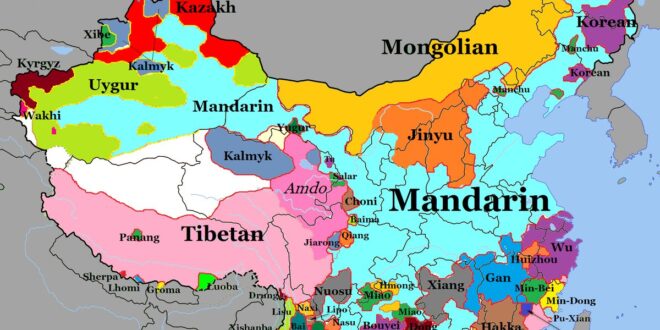In the PRC, where Mandarin Chinese is aggressively promoted as the official language, a similar policy is still in place against Uyghur, Tibetan, Mongolian and other languages, but also against Shanghainese and Cantonese.
While English tends to view the ‘Chinese language’ as a monolith, the phrase actually represents a large diversity of both written and spoken languages, many of which are not mutually understandable.
Linguistically, Chinese languages belong to the Sinitic branch of the larger Sino-Tibetan family of languages. When spoken, Chinese is divided into over 10 languages which each embody a continuum of dialects. The main spoken languages include Mandarin Chinese, Yue (also called Cantonese in English), Wu (sometimes called Shanghainese), Min (that includes Hokkien and Taiwanese), and others.
When written, Chinese also encompasses different scripts. What is called Traditional Chinese in English refers to 繁體字 and represents the form of Chinese characters unchanged for centuries, which is considered the official script in Taiwan, Hong Kong and Macao, and parts of the wider Sinophone diaspora. Specific Chinese languages, such as Cantonese or Taiwanese, also have specific characters unique to their language and absent in other languages.
The term Simplified Chinese is used in connection to a reform implemented in the People’s Republic of China (PRC) in the 1960s that shortened the number of strokes in complicated characters. It is used as the official spelling in the PRC, Singapore and increasingly by the global Sinophone diaspora in media and social media, as well as the United Nations as one of its six official languages in its simplified version since 1971 after it expelled the Republic of China in Taiwan that used the traditional form. The PRC also introduced what is called pinyin — a transliteration of Mandarin Chinese pronunciation in Latin letters for the purposes of international standardization, including when transcribing personal or geographic names.
Taiwan developed its own systems, but today mixes that with pinyin. A form of Mandarin Chinese, spoken by the Hui Muslim Chinese ethnic group, called Dungan in the former Soviet space, also uses the Cyrillic alphabet to write its language, including in literature and in media. Chinese was also tentatively written in the 13th and 14th centuries in an alphabet based on Tibetan letters, a system called phags-pa.
Various Chinese languages are spoken by an estimated 16 percent of the world’s population (about 1.3 billion people) and have official status in a number of Asian countries, including the PRC, Taiwan and Singapore, but are also widely spoken across the wide Sinophone world diaspora estimated to number 50 million people.
The power relations amongst Chinese languages and in regard to other and Indigenous languages are an important part of the history of Chinese languages. In Taiwan, Chinese languages have been used to colonize Indigenous nations. In the PRC, where Mandarin Chinese is aggressively promoted as the official language, a similar policy is still in place against Uyghur, Tibetan, Mongolian and other languages, but also against Shanghainese and Cantonese.
—————————————–
The article was originally published by Global Voices
Cover photo: A map showing plurality of Chinese/https:/Thatsmags.com/
 Infowelat Enformasyon Ji Bo Welat
Infowelat Enformasyon Ji Bo Welat




